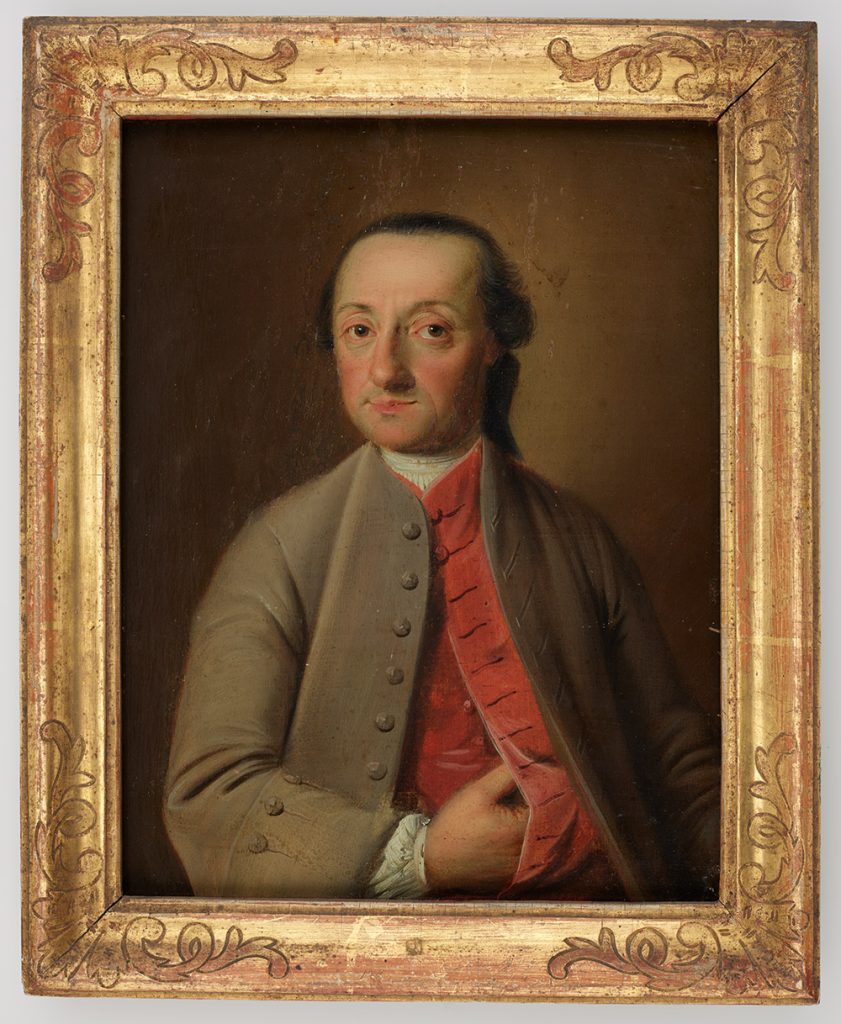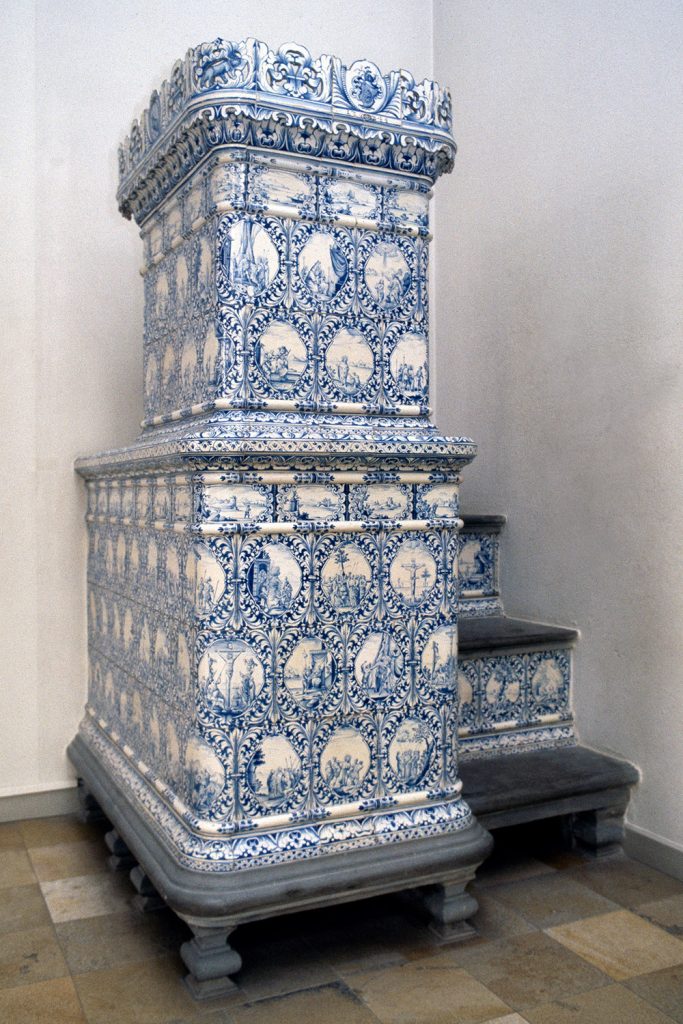
Portrait of Wilhelm Emanuel Dittlinger (1718‒1799), painted in 1758. Photo by the Swiss National Museum in Zurich, SNM LM-7317.
Andreas Heege, Andreas Kistler, 2025
Wilhelm Emanuel Dittlinger (1718‒1799), a Bern burgher, was the son of a Bernese clergyman who worked in Trub and Bürglen respectively (Biber/Hofer 1947, Vol. 1, 222, fn. 184; Staehelin 1969, 3-5). Wilhelm was the second of 11 children. His brother Samuel (1729-1748), eleven years his junior, was serving his apprenticeship as a potter with Wilhelm Emanuel in Bern, when he died in 1748.
Dittlinger Bern_dates Dittlinger Bern_family tree
Judging by the large number of official commissions that can be found in the bailiff’s accounts between 1741 and 1791, Wilhelm Emanuel was one of the most important master potters in 18th century Bern (for a selection see: Staehelin 1969, 5; Boschetti-Maradi 2006, 174 fn. 867; Boschetti-Maradi 2009; additions: Heege/Spycher/Kistler 2020, esp. 197-202; Heege/Frey/Spycher/Kistler 2023). However, so far not a single tiled stove bearing his signature has come to light.

Tiled stove at Trachselwald Castle, dated 1748 (now at the Bernisches Historisches Museum, Inv. H2040). From the workshop of the Bernese potter Wilhelm Emanuel Dittlinger (1718–1799). Photo by Stefan Rebsamen.
Based on written records and confirmed provenance, a tiled stove from Trachselwald Castle bearing the date of 1748 is the oldest extant piece that can be attributed to Dittlinger (Staehelin 1969, 3 and Plate I).
In 1740, he married Anna Maria Laubscher (1707-1790), the daughter of potter Jacob Samuel Laubscher (1676-1733) from Biel, who had been apprenticed to the Bernese potter Hans Heinrich Hess (Boschetti-Maradi 2006, 180). Around the same time, Anna’s brother Samuel (c. 1711-?), who is known to have worked as a journeyman for the widow of Jakob Fruting (1672-1728) in 1730, married Wilhelm Emanuel’s sister Maria Elisabeth Dittlinger (1721-?).
In 1740, Samuel Laubscher was accused by the Bernese master potters Fruting and Herrmann, acting on behalf of the potters of Bern, of helping his brother-in-law Wilhelm Dittlinger to produce a masterpiece (a “Gupfenofen” = a tiled stove with an Ofenturm/tower-stove). The accusation, however, could not be substantiated and the case against Dittlinger was dismissed (archival records on Samuel Laubscher). The fact that he was producing a masterpiece probably means that Dittlinger not only married in 1740 but also set up his own workshop that same year. Wilhelm and Anna Maria had four sons, two of whom lived into adulthood, but none of them became potters.
Laubscher potters’ family tree, Biel/Bienne (PDF)
Dittlinger had his portrait painted in 1758 at the age of 40 (Boschetti-Maradi 2006, 180, Fig. 219). By 1764, if not earlier, he had moved his workshop to 6 Bollwerkgasse lane near the Golattenmatt gate in Bern, where he employed up to three journeymen from Vechigen, St. Gallen and Swabia (cf. Staehelin 1947, 104; Staehelin 1969; Boschetti-Maradi 2006, 180; Brennpunkt 2013). The only other workshop of comparable importance in 1764 was that of potter Johann Jakob Fruting (1718-1795), who also employed three journeymen; they were from Erlach, Schaffhausen and Swabia (Boschetti-Maradi 2006, 179 fn. 945).
 Boschetti-Maradi 2006, Abb. 217.
Boschetti-Maradi 2006, Abb. 217.
Fruting’s house was not far from Dittlinger’s at 7 Vordere Speichergasse Sonnseite. Other potters’ homes nearby included those of Gottlieb Hermann (Golattenmattgasse/later 21 Aarberger Gasse; Gottlieb Hermann had been behind the rather futile attempt of setting up a Bernese faience manufactory in 1757: Staehelin 1947, 103), Johann Rudolf Fätscherin (Golattenmattgasse/later 12 Aarberger Gasse, Schattseite) and David Scheuermeister (in the Bollwerk area). Dittlinger’s main stove painter, Peter Gnehm (1712‒1799), who was originally from Stein am Rhein, also lived in the “potters’ quarter”, when he was permitted to return to the city of Bern in 1754. We can find him at Golattenmattgasse/later 1 Aarberger Gasse, Schattseite (Staehelin 1969, 5). Another tile painter, (Johann) Adam Spengler (1726‒1790), a Schaffhausen citizen, also lived and worked in the same area (Heege/Spycher 2025). According to a 1756 record, he lived “outside the gate” (i.e. the Golattenmatt gate) in the Bollwerk area (Staehelin 1969, 5). The fact that master potters Fruting and Dittlinger were godfathers to one of Spengler’s children suggests that they had a rather close association, and that Spengler may have painted some of their stoves. From 1760, Spengler ran the faience manufactory set up by Franz Rudolf Frisching (1733‒1807, councilman and army colonel) on his estate in the Lorraine area of Bern. In 1763, he was offered a position at the newly set up porcelain manufactory at Kilchberg-Schooren near Zurich.
Translation Sandy Haemmerle
References:
Biber/Hofer 1947
Walter Biber/Paul Hofer, Regesten zur Baugeschichte stadtbernischer Staatsbauten des 16.-18. Jahrhunderts, Bd. I, Bern 1947.
Boschetti-Maradi 2006
Adriano Boschetti-Maradi, Gefässkeramik und Hafnerei in der Frühen Neuzeit im Kanton Bern (Schriften des Bernischen Historischen Museums 8), Bern 2006.
Boschetti-Maradi 2009
Adriano Boschetti-Maradi, Die vier Kachelöfen in den Gesellschaftsräumen der Grande Société, in: Franz C. Brunner, Hôtel de Musique und Grande Société in Bern 1759-2009, Bern 2009, 198-210.
Brennpunkt 2013
Schloss Jegenstorf (Hrsg.), Im Brennpunkt – die Sammlung historischer Kachelöfen Schloss Jegenstorf, Jegenstorf 2013.
Heege/Spycher/Kistler 2020
Andreas Heege/Alfred Spycher/Andreas Kistler, Die Hafner von Hängelen und das Rätsel der Bäriswiler Kachelöfen, in: Gemeindebuch Krauchthal, 2020, 173-256.
Heege/Frey/Spycher/Kistler 2023
Andreas Heege/]onathan Frey/Alfred Spycher/Andreas Kistler, Keramik aus Blankenburg, Abraham Marti (1718–1792), ein bernischer Landhafner, Bd. 16 (Schriften des Bernischen Historischen Museums), Bern 2023.
Heege/Spycher 2025
Andreas Heege/Alfred Spycher, Ein Kachelofen aus Schloss Oberhofen – Wer ist «ASP»?, in: Keramikfreunde der Schweiz, Revue 140, 2025, 103-126.
Staehelin 1947
Walter A. Staehelin, Keramische Forschungen in bernischen Archiven, in: Zeitschrift für schweizerische Archäologie und Kunstgeschichte, 1947, Heft 9, 101-118.
Staehelin 1969
Walter A. Staehelin, Keramische Forschungen aus bernischen Archiven III: Von den Dittlinger Öfen zu den Frischingschen Öfen, in: Keramik-Freunde der Schweiz, Mitteilungsblatt 79, 1969, 3-7.

